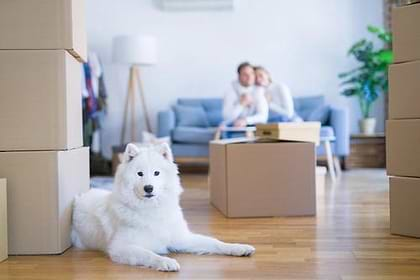
Large breed dogs make delightful companions and are perfect partners for exercise, playtime, or simply cuddling on the couch. It’s no wonder large breed dogs are popular pets! But, living with a large breed dog brings different considerations than living with a smaller breed. For example, you will need a bigger budget and maybe even a bigger car! Whether you already have a large breed dog or are thinking of bringing one into your life, here are some factors you’ll want to keep in mind.
Extra Space Requirements
The most obvious difference between large dogs and smaller ones is, of course, their size. The larger the dog, the more space they take up. Although some larger dogs are okay in tiny apartments, many of them need more room for play and exercise. Their toys, food dish, and bed are larger too. Large breeds can benefit from a crate like our large-sized Revol so that they have their own personal space to rest. Be sure you have enough room in a common area to accommodate your dog’s private den.
Renting an apartment or living in a condominium can be challenging with larger breeds. Landlords and condo boards often have weight limits for the dogs allowed in the building. Be sure to check any regulations before bringing a large breed dog home. They’re relatively small as puppies, but you’ll have a big dog on your hands in no time.
You’ll also notice a large breed’s size when traveling. Your dog might need the entire back seat of the car for road trips, or half the back of your SUV if they ride in a travel crate. If you fly with your dog, they’ll have to travel in cargo as they’re far too big to fit in a carrier at your feet. Finally, if you’re staying in a hotel, consider a larger room to accommodate your dog and their belongings. Or, if you book a rental home or cottage, choose one without size restrictions on pets.
Higher Cost of Ownership
Many dog owners are surprised at how much they spend on their pet each year. According to the 2021-2022 American Pet Products Association National Pet Owners Survey, dog owners estimate spending about $424 a year on food, treats, and toys. Then, there are the additional costs of services like grooming and training, annual vet visits and emergency health care. Don’t be surprised if your expenses are far higher with a large breed pup—the larger the dog, the larger the bills.
Larger dogs eat more than smaller ones. That one bag of kibble might last you two months with a toy breed, but your large breed will go through it in a matter of weeks. Treats might cost you more too, especially if your dog can power chew their way through bully sticks or chew bones. Larger toys often have higher price tags, with the mini version sometimes being less than half the cost of the full-size or jumbo toy. Other supplies like beds, life jackets, dog boots, pet doors, or crates all get pricier as the size increases. And don’t forget supplements and medication—arger dogs need larger doses and therefore costs increase.
Different Nutrition Requirements
Speaking of food, large breeds have different nutrition requirements than smaller dogs, particularly when they’re puppies. Large breed puppies have a lot more growing to do and it takes them longer to do it. Just think, a Boxer and a Yorkshire Terrier are both pretty small as puppies, but the Boxer will grow to be around 80 pounds by adulthood, whereas the Yorkie will be done growing around seven pounds.
Because large breed puppies have a fast growth rate, they’re sensitive to the nutrients and calories in their diets. If they grow too fast, it can cause skeletal issues known as developmental orthopedic disease which encompasses conditions such as hip dysplasia and osteochondrosis. Therefore, you need to provide a large breed pup with a diet formulated for their special requirements. Even once your large breed dog is fully grown, you’ll still want to buy an appropriate, high-quality food. Consider one formulated specifically for large breeds with glucosamine for joint health.
Activity Level Concerns
Another consideration with large breed puppies is their activity level. They need lots of exercise, but it’s important to be cautious in terms of stress on their joints. The growth plates in large breeds fuse later than in small breed dogs, and until those plates have closed (usually around a year and a half of age) your puppy mustn’t experience anything too strenuous. Typical puppy play is fine, but don’t take your pup for a long run on a hard surface or encourage them to jump on or off furniture.
Time for Training
Every dog needs training, no matter their size. It makes them polite members of society and better family members. Plus, it provides essential enrichment and eases anxiety by teaching your dog what you expect from them. But let’s be honest—if a toy breed jumps on you or pulls during a walk, it’s far less of an issue than if a large dog does the same. Large breeds can knock you over if they jump or dislocate your shoulder if they pull. They are simply more powerful than their smaller counterparts. That means you need to put in the time and effort to train your large dog, especially how to walk and greet politely.
Another common large dog problem is counter surfing. Because of their height, large dogs may consider the kitchen counter and dining room table all-you-can-eat buffets. To prevent this behavior, teach your dog to go to their mat when you’re cooking, as well as a solid “leave it” cue. Whatever behavior you’re training, use techniques that are based on positive reinforcement to get the best response from your large breed dog. They will learn quickly and get hooked on the training game if you keep things fun and rewarding.
Shorter Life Span and Slower Maturation
Not only do large breed puppies take longer to grow to adult size, they also take longer to mature emotionally. That means you’re looking at a year or more of having a pet with the personality and energy of a puppy. Your 80-pound Labrador Retriever might behave like a teenager until they are three! We know this can certainly be challenging, but if you stay consistent and patient, it will be smooth sailing once your dog matures.
One last thing to consider is your larger dog’s life span. In general, the smaller the dog, the longer they live. For example, a Chihuahua has a life expectancy of 14-16 years, whereas a Golden Retriever lives for 10-12. But that’s still a decade of canine companionship—consider it motivation to make every year count!
You and your large breed dog have many years of fun and friendship ahead of you. Whether you’re participating in a dog sport, playing fetch, or using your pet as a foot warmer, we believe it’s well worth making room in your life for a large breed pup.

Stephanie Gibeault
Stephanie Gibeault is a freelance writer and certified professional dog trainer with a Master of Science in animal behavior. She is passionate about combining her love of animals with her writing skills to educate and entertain. When she’s not at her keyboard, you can find her tap dancing, taking photographs, or tweeting (@GibeaultWrites).
You might also like
Crate training tips, stories and inspiration
View all blogsIn Your Diggs
Share your photos with #DiggsPet and tag us @DiggsPet on IG and TikTok.


